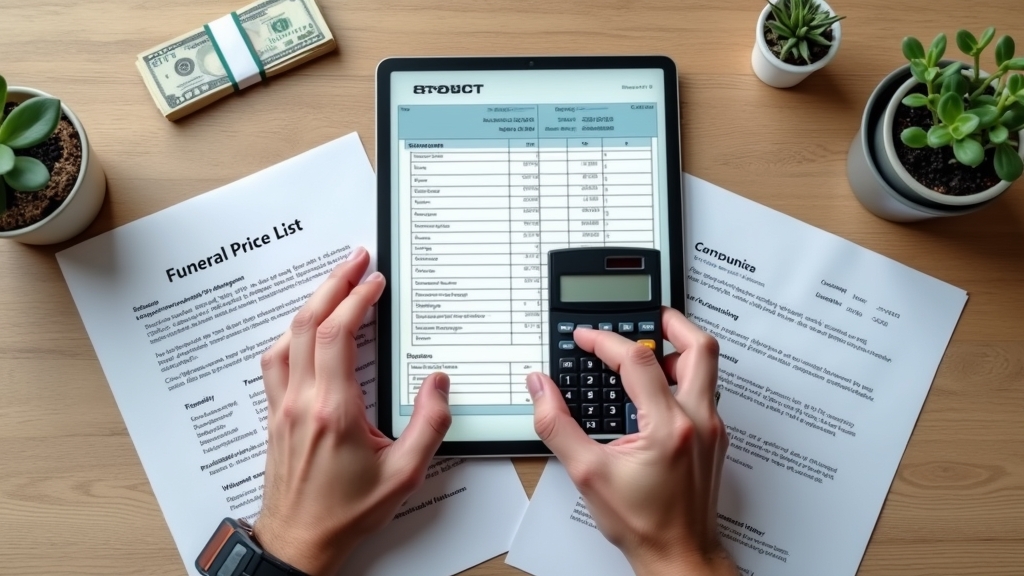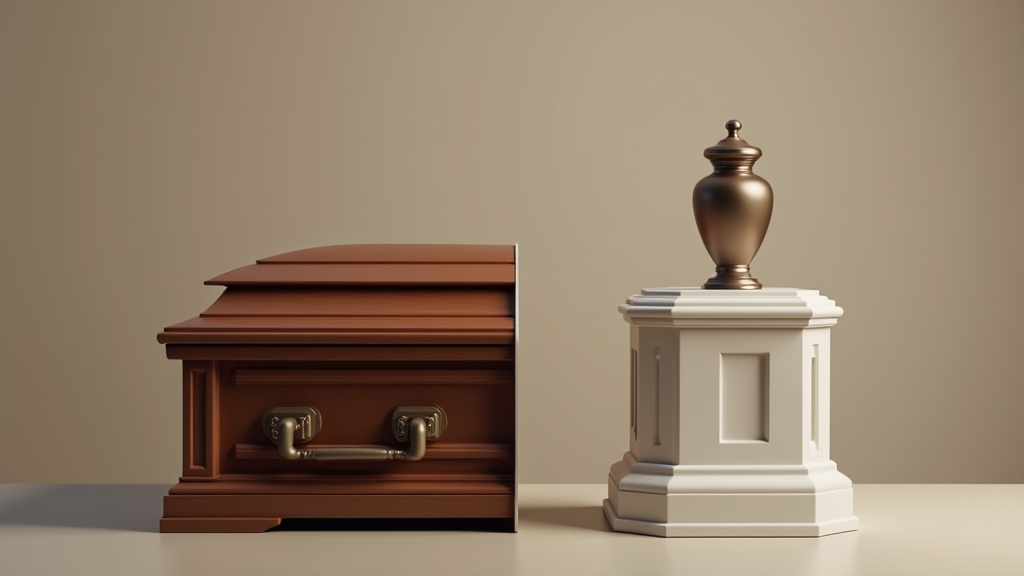Funerals provide an opportunity to say our final goodbyes to loved ones and get a sense of closure.
In theory, funerals are simple to plan, but they can be challenging to execute. The reason for this is that these experiences occur during the grieving process when mourning a loved one’s death. With emotions running high, it can be quite difficult to know where to begin or how to go about the funeral arrangements.
To make things a bit easier for you, we’ve put together a step-by-step guide on how to plan a funeral from start to finish. Whether you’re planning a DIY funeral or want to hire a funeral director, this guide will simplify the funeral planning process and provide a checklist to follow.
10 Steps to Planning a Funeral
1. Choose a Funeral Home
You can ask for referrals from a friend. Having a referral might help you identify a provider that is a good fit for your requirements and goals. You can also search online to find one.
Type in “local funeral homes near me” into the Google search box and look through the results to find a funeral home with great reviews.
Alternatively, you can search for funeral homes in your area using online directories. There are about 28,800 funeral homes in the U.S, so you have a huge pool to choose from.
When choosing a funeral home, keep the following in mind:
- Take into account the location.
- Look for positive reviews on the internet.
- Look for complaints at the Better Business Bureau.
- Examine the services offered by the funeral home.
- Check to see if the funeral home is clean, well-kept, and accommodating to your needs.
- Consider how the funeral home can assist you in meeting your requirements and ideals.
- Find out if the funeral home can meet your religious or cultural requirements.
- Consider the cost: A funeral parlor is required by law to offer consumers a general price list.
2. Hire a Funeral Director

Many people choose to leave the funeral arrangements to a funeral director, especially if they are overwhelmed. However, it comes at an additional cost. The burial director can take charge of ensuring the deceased is cared for, as well as the processes and organization of the funeral ceremony. They can also provide you with support and general advice to make informed decisions.
You can check with the National Association of Funeral Directors on the internet.
Note: You don’t need a director if you want to plan a small, inexpensive funeral. You can save on the cost by doing things yourself.
3. Choose a Service Type
There are numerous funeral service types to choose from. It can be a religious funeral service held in a church, chapel, or other religious places. It usually entails praying and doing rituals based on the deceased’s religious beliefs.
Also, there are fraternal funeral services, like a military funeral, whereby the fraternal activity is taken into account. Military funeral services typically involve a guard of honor.
There’s something for everyone, regardless of your beliefs, including a traditional burial, burials at sea, humanist and civic funerals, and green burial. Typically, you’ll choose a funeral type that aligns with the deceased’s end of life wishes or beliefs.
4. Establish a Budget and Determine Who is Responsible for Payment

Funerals cost money, and it’s impossible to carry out the funeral planning process without a budget. If your loved one arranged for their final expenses ahead of time, they may have already covered some or all of the costs. If they haven’t already paid for it, you’ll need to determine who will and how they will pay for the funeral.
If the deceased had a life insurance policy, then that could help cover the cost of the burial. But it may not arrive in time for the burial. In that case, you’ll need to look for other ways to raise money.
The Funeral Consumers Alliance saves the average funeral cost an average of roughly $8,000. But you can create a budget based on the funds available to you and eliminate anything that’s not necessary to give your loved one a proper funeral.
5. Decide on a Date and Send Out Invitations
You also have to choose a date for the funeral. You might need to talk to a religious group, a fraternal group, or other groups depending on what kind of service you need.
If the deceased was a veteran, you may choose to request military honors. To do so, fill out the relevant forms and submit them to the military. This requires a 48-hour notification from the military. If you don’t want to go to the cemetery, the military can perform all honors at the church.
The next step is to send out invitations for the funeral. For close friends, family and loved ones a phone call would suffice. If the news hasn’t reached the wider circle of friends, they may need to be notified in writing. The rest will be informed via Facebook announcements or obituaries in local publications.
6. Decide on a Funeral or Memorial Service Location
The next step is to look for locations for the ceremony, graveside service, reception, and last resting place. The venue will be dependent on the type of ceremony.
These venues should be chosen based on what you know about the deceased. Would they prefer a green burial or traditional funeral, for example? Would they prefer a church service or worship in the open air? Would they wish their ashes to be scattered or displayed in their home?
7. Make Cemetery Arrangements
Once you’ve decided on a location and chosen a cemetery, you’ll then need to contact the specific cemetery to buy a plot or vault and then schedule the burial. Contact the cemetery’s director and he or she will guide you through the funeral planning process and also the graveside service. Ensure to confirm cemetery arrangements as part of the final arrangements.
8. Decide on Final Disposition: Casket or Cremation?

The next step is to decide on the form of final disposition, whether it’s a casket or cremation container. Most funeral homes will likely ask you to select and purchase a casket, burial vault or urn. However, you have several other options and you should make sure to check elsewhere to save cost.
Caskets and urns prices vary, depending on materials, design, and decorative embellishments.
There are many different types of coffins from which to choose, and the price varies based on the material they’re made of. You’ll need to know the deceased’s height and weight to buy the proper size coffin. The same goes for an urn.
9. Choose Final Touches
You might want to think about getting your loved one some accessories, such as clothing or jewelry. If you hired one, discuss this with the mortician.
10. Make Other Arrangements for the Memorial Service
You may choose to schedule a memorial service in addition to the funeral and cemetery arrangements. This can be a larger get-together for extended relatives and friends to say their final goodbyes.
It’s also a great time to encourage people to help plan the funeral or memorial service.
Other Funeral Arrangements
Find and Make an Appointment with a Clergy Member or Officiating Clergyman
You’ll be in a better position to meet with the minister or celebrant and start focusing on the details of the service after the time and date of the funeral have been established.
The minister or celebrant will be able to offer advice and recommendations on the structure of the service, including hymns and prayers, as well as help with the creation of the order of service booklet details. They can offer suggestions for hymns, music, psalms, and readings.
Prepare an Obituary

Obituaries are death notices typically published in a local newspaper and contains information on the deceased’s life and, in some cases, the memorial services. To write an obituary, you’ll need to gather personal information about the deceased by speaking with the next of kin and other friends, family and loved ones.
Once you’ve written the obituary, you can then send it to the local newspaper alongside a photo of the deceased.
Select Speakers
If you’d want a loved one to deliver the eulogy, say a few words, or simply greet family members, let them know as soon as you’ve worked out a few things. Discuss the situation with family, close friends and love ones, and make it clear that they are free to say “no” if they are uncomfortable.
Select Scriptures and/or Other Readings for the Service
If you’re having a religious ceremony, the minister or close family member or friend can read the deceased’s favorite passage, or any passage that reminds them of that person, or something else they think will comfort them. Also, get the eulogy and other speeches ready. You may need to speak to the officiating minister about the scripture readings.
Non-religious texts are frequently welcomed, even if the ceremony is religious. They fulfill the same goals as religious text sections but are not based on faith.
Choose Music
Music is frequently seen as an important component of a funeral service’s order of service. These days, the music played during the service is chosen to reflect the characteristics of the deceased person. Religious organ music, chart songs, classic rock, and choices with a hint of humor are among the options.
If the funeral is held in a church or other place of worship, the music that can be played may be limited based on the religious traditions. This may or may not be the case, depending on how rigid that particular religious branch is. During the service, songs or hymns may be performed, with attendees urged to sing along.
Arrange Order of Services
An order of service is a funeral service’s schedule. It’s usually a printed booklet that’s handed out to attendees at the funeral and mailed to those who can’t attend. It provides specific details about the funeral service, including the hymns, songs, readings, poems, or prayers that are part of the service.
You also need to include details about the deceased, from their name to date of birth, a statement, and a biography. Also include information about the burial and wake, so people will know what to expect next.
On the last page, include another photo and a list of charities dear to the deceased person. Then a thank you message to guests and attendees.
Arrange for Food and Drinks
Food and drinks are necessary for the funeral service. After the crying and grieving, your visitors will likely need something to eat or drink. Whatever you do, don’t do the catering by yourself. Request that some of the people at the funeral come two hours early to help you make the food.
You also need to provide beverages and alcohol for those who want it.
Contact a Gravedigger
Contact a grave marker to plan for the grave to be dug, or you can find people to do it in some cemeteries. Inquire about the cemetery’s criteria. Some cemeteries only have one grave digger on staff. They will inform you as to who that person is and what it will cost to use any of the cemetery property.
Arrange Flowers
Funeral flowers can be a great way to pay respect to your loved one. Friends, family and loved ones may also want to send flowers to express their condolences. You’ll need to designate someone to accept flowers, arrange flowers, and make sure everything runs properly before, during, and during the event. This individual can also help people who require directions to the church or facility.
Make Transportation Arrangements
When planning a traditional funeral, the coffin is frequently transported in a hearse to the service. It is subsequently followed by limos carrying friends and relatives. If you have a funeral director, he or she can assist you with this. However, just because it’s conventional, doesn’t mean you have to hire a hearse and limo.
Many people are opting for more intimate funeral conveyances such as tractors and fire trucks. You can also choose a less expensive mode of funeral transportation or ask everyone to drive themselves to the services to help save some money.
Add a Personal Touch
You may add a lot of personal touches to a funeral or memorial service website. A personalized funeral can have a large photograph printed, set up a funeral or memorial service website, or collect funds for a charity. You can also collect cash or set up a free online donation page.
Morticians can help you with this, or if you want to donate to the venue, contact the minister.
Frequently Asked Questions
How Much Does a Funeral Cost?
One reason many individuals are taking charge of their funeral planning is the escalating cost of funerals. The National Funeral Directors Association estimates that the typical funeral costs $9,135. The average traditional burial cost is around $6,000 if you choose cremation with a funeral. You’ll also need to budget for a burial plot, a casket or an urn (if you choose cremation), a headstone, and other funeral expenses for a memorial service. For many funeral services, this brings the total cost to around $10,000.
Who is Responsible for the Cost of a Funeral?
The expense of the deceased person’s funeral may be covered if they purchased a funeral plan. They may have also had a life insurance policy in place, which could have helped with funeral costs.
Alternatively, they may have had enough money in their estate to cover it. If this is the case, the funeral bill will be paid by the estate’s executor.
Otherwise, the funeral is usually paid for by a relative or friend. If this happens, the friend or relative might be entitled to obtain the money for the funeral returned from the estate if there is enough to cover it.
How can one Save Money on a Funeral Service?

One way to save money on funeral planning is to do it yourself instead of hiring a director. While planning a funeral yourself can be overwhelming, it’ll allow you to know what’s needed and what’s too costly when making funeral plans. Other options include:
- Going for direct cremation.
- Go for a less expensive coffin, like a cardboard coffin.
- Consider having the wake at home, so you won’t pay for a venue.
- Don’t hire transportation. Ask people to drive themselves to the funeral.
- Ask friends and family for help transporting the casket.
- Prepare the food on your own instead of hiring caterers.
What if You Don’t have the Financial Means to Pay for a Funeral?
You don’t need that much money to plan a funeral. If the deceased doesn’t have any income to sponsor the funeral, you can ask for donations from friends and family member to cover the cost of a cemetery plot and bury the deceased without any formal ceremony. Alternatively, you can take a funeral loan to cover the cost of funeral and memorial service. You’ll find various funeral plans with diverse payment options. Note that a funeral loan is just a personal loan, so the terms are similar.
This is why it’s important to consider planning ahead and make essential plans for their funeral funding.
When Someone Dies, How Long does it Take to Plan a Funeral?
A funeral usually takes one to two weeks to prepare, though it might be sped up if the deceased gave explicit instructions. Funerals are usually held soon after someone dies, which speeds up the final arrangements.
